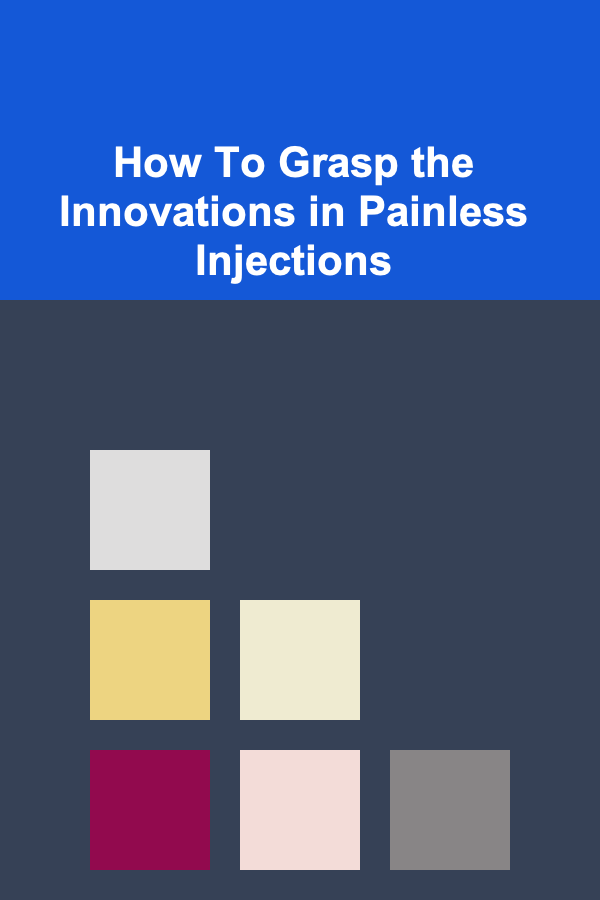
How To Grasp the Innovations in Painless Injections
ebook include PDF & Audio bundle (Micro Guide)
$12.99$9.99
Limited Time Offer! Order within the next:

The history of injections dates back centuries, with early forms of needles being used for medical procedures as far back as the 19th century. However, one of the most significant advancements in the medical field has been the evolution of pain management during injections. For decades, the fear of needles and the discomfort associated with injections has been a common obstacle to both patients and healthcare providers. Over time, numerous innovations have emerged to reduce pain, improve patient experience, and enhance the overall effectiveness of injections.
The emergence of painless injections is not only a product of technological innovation but also a result of interdisciplinary research combining fields such as materials science, pharmacology, and engineering. In this article, we will explore the key innovations in painless injections, focusing on their mechanisms, technological advancements, and the future of needle-free administration.
The Challenges of Traditional Injections
Before delving into the innovations, it's essential to understand the challenges that traditional injections pose. Injections are still one of the most effective ways to administer medications, especially in cases where rapid absorption is necessary. However, for many people, the fear of needles, medically known as trypanophobia, can be a significant psychological barrier. Even beyond fear, the physical discomfort of a needle entering the skin can be a deterrent to seeking necessary treatment.
In addition to the psychological and physical discomfort, traditional injections can lead to adverse effects such as bruising, swelling, and irritation at the injection site. These side effects can cause patients to avoid seeking timely medical interventions, which can have long-term health consequences.
To address these challenges, medical researchers have focused on developing painless injection methods, as they not only reduce patient anxiety but also improve adherence to medical regimens. In the following sections, we will discuss some of the groundbreaking innovations in this field.
The Rise of Needle-Free Injections
1. Jet Injection Technology
One of the most significant innovations in painless injections is the development of jet injection technology. Unlike traditional syringes, which use needles to inject substances, jet injectors deliver medications through the skin using a high-pressure stream of liquid. The jet injector creates a rapid, high-pressure stream that penetrates the skin and delivers the medication directly into the tissue without the need for a needle.
This technology relies on the principle of fluid dynamics, where the force generated by the high-pressure stream allows the liquid to pass through the skin with minimal sensation of pain. Jet injections are typically faster than traditional injections, and because there is no needle involved, the procedure is perceived as significantly less painful.
Jet injectors have been used in a variety of medical applications, including vaccines, insulin delivery for diabetic patients, and other intramuscular or subcutaneous injections. Additionally, jet injectors can reduce the risk of needlestick injuries, making them an attractive alternative in situations where needle reuse is a concern.
However, while jet injectors offer a pain-free experience, there are challenges to their widespread use. For example, the high-pressure stream can sometimes cause local tissue damage if not properly calibrated. Furthermore, the technology requires precision to ensure that the medication is effectively administered, which can be difficult in certain settings.
2. Microneedle Patches
Another promising innovation in painless injections comes in the form of microneedle patches. These patches are covered with tiny needles, each typically measuring between 50 to 900 micrometers in length, which are too short to penetrate deeply enough to cause pain. These micro needles puncture the outer layer of the skin, delivering drugs directly into the dermal or epidermal layers without reaching nerve endings.
Microneedles are designed to be minimally invasive, offering a more comfortable and less traumatic alternative to traditional needles. The patches are easy to apply and can be self-administered by patients, which makes them a practical option for patients who require frequent injections, such as those with chronic conditions like diabetes.
The beauty of microneedles lies in their ability to bypass the pain receptors in the deeper layers of the skin. The needles are so small that they only affect the superficial layers of the skin, where there are fewer pain receptors. As a result, many patients report little to no pain during application.
Several companies and research institutions have been working on developing microneedle-based technologies for drug delivery, including vaccines, insulin, and even cosmetic treatments like botulinum toxin (Botox) injections. Microneedle patches are expected to revolutionize not only the comfort of injections but also their accessibility, especially in remote or underserved areas.
3. Transdermal Drug Delivery Systems
Transdermal drug delivery systems (TDDS) represent another innovative approach to painless injections. Unlike traditional injections, which require a needle, TDDS use the skin as a conduit for drug delivery. These systems rely on skin permeation enhancers such as chemicals, electrical impulses, or ultrasound waves to increase the skin's permeability, allowing drugs to pass through without the need for needles.
One of the most widely used forms of TDDS is the transdermal patch, which delivers medications such as nicotine, pain relievers, or hormone treatments through the skin over an extended period. While these patches do not provide an immediate effect like injections, they are convenient for long-term drug delivery without the need for repeated injections.
In recent years, innovations have been made in the field of iontophoresis, where a small electrical current is used to drive charged drug molecules through the skin. This technique is being studied for its potential in delivering a wide range of therapeutic agents, including vaccines and biologic drugs, without the need for invasive procedures.
4. Vibrational and Thermal Numbing Techniques
Another way to minimize pain during injections is through the use of vibrational or thermal numbing techniques. These methods involve applying vibrations or heat to the skin before administering the injection. The idea is that the sensory nerves that detect pain can be "distracted" by the vibrations or the heat, making the injection experience less painful.
Vibrational numbing techniques have been successfully used in combination with traditional needles to reduce the perception of pain. By disrupting the nerve signals associated with pain, vibrations can make the needle insertion process more comfortable for patients. Similarly, warming the skin with a small heating device prior to the injection can reduce the sharp sensation often felt when the needle penetrates the skin.
These methods are typically used in conjunction with other innovations, such as microneedles or jet injectors, to further improve patient comfort. They are non-invasive and have been shown to significantly reduce pain, making them a useful addition to the toolkit of modern medical practitioners.
The Future of Pain-Free Injections
The future of painless injections is bright, with ongoing research and development leading to even more innovative solutions. Here are some potential advancements that could shape the next generation of injection technologies:
1. Smart Needles and Autonomous Injection Systems
One area of focus is the development of smart needles that can automatically adjust their insertion depth, angle, and speed to minimize pain and maximize medication absorption. These needles could be controlled by robotic systems or automated devices, making them ideal for precision-based applications.
Smart needles could also feature real-time monitoring systems that track the injection site's response to the medication and adjust the delivery rate accordingly. Such innovations would make injections more effective and personalized, improving both comfort and efficacy.
2. 3D Printing of Customized Injection Devices
3D printing is a rapidly advancing technology that holds significant potential for creating customized injection devices. In the future, patients may have access to personalized injection systems tailored to their specific medical needs. 3D printing could be used to create customized needle-free injectors or microneedle patches, allowing for more targeted drug delivery.
3. Non-Invasive Ultrasound and Laser Injection Technologies
Research into non-invasive ultrasound and laser technologies for drug delivery is still in its early stages but shows promise. These methods could create temporary pores in the skin or enhance drug permeability, allowing medications to be delivered directly into the bloodstream without the need for needles.
Ultrasound and laser-based technologies could allow for more precise drug delivery, as well as enhance the efficiency of the absorption process. These non-invasive options could eliminate the need for needles altogether, offering a pain-free and convenient alternative for patients.
4. Gene Therapy and Biologic Injection Innovations
As the field of gene therapy and biologics continues to advance, the methods for administering these complex treatments may also evolve. New biocompatible materials could be developed to ensure that these treatments are delivered efficiently and painlessly. Researchers are also exploring ways to make the injection process itself more comfortable by optimizing drug formulations and delivery methods.
Conclusion
The development of painless injection technologies has the potential to revolutionize medical care. From jet injectors to microneedle patches and transdermal systems, innovations in this field are making injections more comfortable, less invasive, and more effective. As research continues and new technologies emerge, the hope is that patients will no longer need to fear the pain and discomfort traditionally associated with injections. Ultimately, these innovations will improve patient adherence to treatments, enhance medical outcomes, and make healthcare more accessible and patient-friendly.
As the future of painless injections unfolds, it is clear that the combination of technological advancements and interdisciplinary research will continue to push the boundaries of what is possible, transforming the way we administer medications for years to come.

Creating Engaging Online Experiences: Best Practices for a Thriving Web Content Management Role
Read More
How to Successfully Save on Home Renovation Projects: A Complete Guide
Read More
How to Upcycle Household Items for Beauty Organization
Read More
How to Use Trays for Stylish Organization in Every Room
Read More
How to Understand the Big Crunch and Big Freeze Theories
Read More
How to Grow Edible Flowers in Urban Containers
Read MoreOther Products

Creating Engaging Online Experiences: Best Practices for a Thriving Web Content Management Role
Read More
How to Successfully Save on Home Renovation Projects: A Complete Guide
Read More
How to Upcycle Household Items for Beauty Organization
Read More
How to Use Trays for Stylish Organization in Every Room
Read More
How to Understand the Big Crunch and Big Freeze Theories
Read More